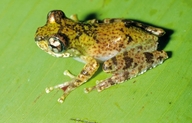|
Description
M 25-28 mm. Tibiotarsal articulation reaches at least the nostril, sometimes beyond snout tip. Hand with some webbing, foot webbing 1(0), 2i(1), 2e(0), 3i(1), 3e(0), 4i(1), 4e(1.5), 5(0.5). Dorsal skin smooth. Dorsally irregularly marbled brownish or greyish with small reddish dots and a dark hourglass marking. Ventrally white, ventral side of thigh, shank, tarsus, foot, hand and webbing deep red.
Similar species: Most similar to B. pyrrhus but distinguished by the deep red colour ventrally on limbs. Distribution and Habitat
Country distribution from AmphibiaWeb's database: Madagascar
Southeastern Madagascar: Andohahela, Manantantely, Nahampoana. It occurs between 200-400m asl primarily in pristine and secondary rainforest (Raxworthy and Andreone 2008).Life History, Abundance, Activity, and Special Behaviors
Habits: Males call from the vegetation alongside streams in primary rainforest, 1-2 m above the ground.
Calls: Similar to that of B. pyrrhus but of less “metallic” sound.
It breeds in streams (Raxworthy and Andreone 2008). Trends and Threats
Vulnerable: extent of occurrence is less than 20,000 km2, it is known from fewer than ten locations, and there is continuing decline in the extent and quality of its habitat in southeastern Madagascar. It occurs in the Parc National d'Andohahela (Raxworthy and Andreone 2008). Possible reasons for amphibian decline General habitat alteration and loss
Habitat modification from deforestation, or logging related activities
Intensified agriculture or grazing
Urbanization
Habitat fragmentation
Comments
Taken with permission from Glaw and Vences (2007).
References
Glaw, F. and Vences, M. (1994). Amphibians and Reptiles of Madagascar. M. Vences and F. Glaw Verlags GbR., Köln.
Glaw, F., and Vences, M. (2007). Field Guide to the Amphibians and Reptiles of Madagascar. Third Edition. Vences and Glaw Verlag, Köln.
Raxworthy, C. and Andreone, F. (2008). Boophis haematopus. In: IUCN 2008. 2008 IUCN Red List of Threatened Species. www.iucnredlist.org. Downloaded on 07 April 2009.
Originally submitted by: Miguel Vences and Frank Glaw (first posted 2008-12-04)
Edited by: Henry Zhu (2009-05-05)Species Account Citation: AmphibiaWeb 2009 Boophis haematopus <https://amphibiaweb.org/species/5929> University of California, Berkeley, CA, USA. Accessed May 1, 2024.
Feedback or comments about this page.
Citation: AmphibiaWeb. 2024. <https://amphibiaweb.org> University of California, Berkeley, CA, USA. Accessed 1 May 2024.
AmphibiaWeb's policy on data use.
| 